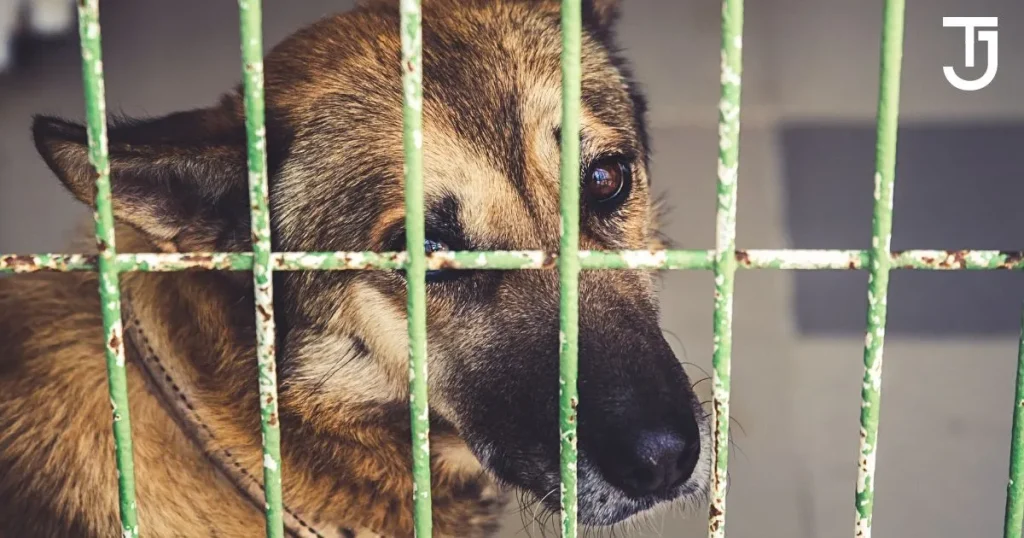Dog Eye Allergies vs Infection: How to Identify?

Dog eye allergies vs infection how to identify them? Do you think your pet’s eyes are getting itchy? Because of something like allergies or an infection. It can be hard to tell the difference, which can cause your pet pain and make it take longer to get care.
Eyes of dogs can get allergies and infections just like people. Skin can turn red, swell, and leak when these things happen. It is, nevertheless, different for each. You should know the difference between allergies and eye diseases so you can take good care of your dog.
Look into why your dog’s eyes are wet, red, or swollen if you notice that they are. You can get the right care and identify the problem faster if you know the signs and symptoms of each. Because you want to better take care of your dog, let’s talk about how dog allergies and eye infections are different.
Common Eye Issues in Dogs

Puppy eyes, also called “pink eyes,” are normal for dogs. And because of that, your dog’s eyes might get red, itchy, and wet. Lumens may become cloudy as cataracts get worse over time. The older dogs might have a harder time seeing this. Your dog’s eyes will hurt and swell up if it has glaucoma. If you don’t take care of them, they might lose their sight. Without enough space for the eye, keratoconus could develop, which is painful and swollen. Someone with this condition is also known as having keratoconjunctivitis sicca, which actually refers to “dry eye”. An awful lot of dogs have these eye problems. Make sure your dog gets regular eye care and visits to the vet to avoid or treat these issues.
What are Eye Allergies in Dogs?
Allergies or the environment they live in might cause eye issues in dogs. Dogs that have these allergies frequently have itchy, red, swollen, and leaking eyes. Dogs with frequent eye scratches may notice an increase in size or reddening of their eyelids. That is the extent of their injuries. Put another way, give the vet a call as soon as you suspect that your pet may be experiencing vision problems. It is feasible to have a precise diagnosis and a customized treatment plan. Examine the overall and eye health of your dog. If they had an eye allergies straight away, they would fare better and experience less difficulties.
Read Related Article: Dog Eye Allergies: Causes, Symptoms and Effective Treatments
Common Triggers for Eye Allergies in Dogs
Dogs can get eye allergies from pollen from plants, weeds, trees, and dust mites, as well as from mildew, smoking, and some shampoos and cleaning products.
Air pollution from vehicles and indoor pollutants can make dog eye problems worse. Some treats and foods can make dogs allergic.
Because different things can cause eye allergies in different dogs, keep an eye on his symptoms and take him to the vet. At any age, your dog could get allergies.
Symptoms of Eye Allergies in Dogs

Like people, dogs suffer eye allergies. Pet owners must know dog eye allergy symptoms for optimum outcomes.
Dog eye allergies induce tears or discharge. Your dog may have an allergic response if their eyes are wet or discharge yellow or green.
Check eyes for discomfort, edema, and redness. Allergies can swell and redden eyes. To relieve pain, dogs may claw or wipe their eyes on furniture or carpet.
Allergic dogs blink or squint. Probably inflamed eyes. Allergen eye discomfort may make your dog blink more.
Eye allergy dogs get “cherry eye,” where the third eyelid protrudes. Severe pain requires veterinary help.
Vets will identify and treat dog eye allergies. They may prescribe antihistamines or eye drops for your dog. Severe allergies may require medication or testing.
Your allergy-prone dog’s eyes might benefit from care. Pet care may keep them happy and active.
Recognizing Dog Eye Infections
If you don’t treat dog eye infections, they can hurt and last for a long time. You should know how to spot them. As a result, dogs often have red, flushed, swollen, squinted, light-sensitive, and teary eyes. Immediately take your dog to the veterinarian if you notice any of these signs. Not getting care for an eye issue could hurt your dog for a long time or even make them blind if it is not fixed. You can help find infections early and get your dog the care it needs if you keep an eye on its eyes and notice anything that doesn’t seem right.
Types of Eye Infections in Dogs
Infected eyes in dogs can hurt and bother them for a long time, just like they do in people. This is accurate for both people and dogs. Dog and cat owners need to know about the different eye diseases their pets can get so they can take good care of their pets. This is because many animals can get eye problems.
The Four Most Common Types are Listed Below:
- Conjunctivitis (pink eye)
- Blepharitis
- Keratitis
- Uveitis
Causes of Eye Infections in Dogs

Dog eye problems can be bad, even though we love them. Dogs’ eyes can get hurt by many things. Pet owners should learn about these illnesses for their dog’s health and well-being.
An eye infection in dogs can be caused by bacteria or viruses. Dogs that have staphylococci, streptococci, herpesvirus, or adenovirus infections may get red, swell, and leak. Others can get sick from touching sick animals or things.
Random things or disposables can hurt a dog’s eyes. There are many small things that can hurt dogs and other animals, like getting eye infections. Infections can enter through cuts and towels.
Asthmatic animals can get eye infections. Similar to people, animals can be allergic to things like pollen, dust, mold, and other things in the environment. Optic problems and inflammation are two examples. Dog allergies make eyes watery, red, and itchy.
The eye diseases keratoconjunctivitis sicca and entropion may get worse in dogs whose eyelashes rub against the cornea. These sicknesses raise the chance that your eyes will have problems.
Beyond that, dogs can get dirty eyes from not being clean. If you don’t clean your dogs’ eyes regularly, germs, debris, and other things can get in and make the dogs sick.
Symptoms of Eye Infections in Dogs
Look out for symptoms that indicate your pet is ill or in pain, owners. Dogs frequently have eye sores. You may detect and cure the issue more quickly if you research signs of dog eye infections. Take a look at these things:
1. Excessive tearing or discharge from the eye
For that matter, this could also mean that your dog is sick. Carefully watch the release; it could be clear, yellow, green, or even look like a scar. Changing the way something smells or tastes could also mean there is a bigger problem. Because of this, the illness could be found early and treated well. Carefully watch for pain or other strange signs that come with the fluid. It’ll be easy to figure out what’s wrong and how to treat it best.
2. Redness or swelling around the eye
As a body’s natural defense against illness or damage, inflammation is a complicated process involving many immune cells and chemical messengers. When there is inflammation around the eye, it usually appears red because the immune system and blood flow work harder in that area. Because of this increased arterial activity, blood vessels get bigger, which makes the tissues around them look redder than they normally would. Learning about the complexities of inflammation and how it affects the body can help you understand how it defends itself.
3. Squinting or blinking more than usual
Certain germs, viruses, or foreign items can hurt or irritate a dog’s eyes, making it blink or squint all the time. Looks like their eyes are changing; they might be getting cloudy. In this case, they may also cry more or be more sensitive to light. If they have an illness that gives them red eyes, gunk, or swelling around a badly hurt eye, blinking can make their eyes look worse. Please bring your pet to the vet right away so that they can properly diagnose the problem and give it the right care to protect its eyes and health as a whole. Focus on problems early on if you want your dog to be healthy and happy.
4. Discoloration or cloudiness of the eye
There may be an imminent threat that needs to be checked out as soon as by a vet if the eyes become cloudy, change color, or look different. In more serious cases, cataracts, spots on the lens, or even diseases that affect the whole eye are more frightening. Doing something about these kinds of signs immediately will help your pet’s eyes and health in the long run. Regular visits to the vet will help them find and fix any eye problems quickly. And this is what will keep their eyes healthy. This is the best time to move if you want to keep your pet healthy for a long time.
5. Sensitivity to light
Dogs with visual impairments may be more light-sensitive. Sometimes, they hide from the brightness or squint because it’s too hot outside.
6. Rubbing or scratching at the eye
An eye injury such as a scratch or contact may exacerbate an existing condition. Notify the veterinarian immediately about your dog’s misbehavior.
Key Differences Between Allergies and Infections
Dog Eye Allergies and Infections are the most common health issues for dogs. Pet owners sometimes get confused because the symptoms are so similar. By Understanding the main distinctions between allergies and infections, you can easily identify and treat your beloved pet quickly. Let’s check the key differences between allergies and infections
Dog Eye Allergies vs Infection:
| Topic | Dog Eye Allergies | Dog Eye Infections |
| Cause | Most of the time, external triggers like pollen, dust mites, molds, or certain foods can cause allergies. | Malaria, fungus, and parasites can also cause infections, but bacteria and viruses are the most common types. |
| Common Symptoms | This includes heat, itching, bloating around the eyes, more tears, and pawing at the eyes. | Infections can make their eyes red, swollen, or watery, just like allergies can. But they can also have more serious symptoms, like pus or mucus release, pain, or blinking that doesn’t make sense. |
| Prevalence | Depending on what the dog is allergic to, allergies can only happen during certain times of the year or all year long. | Dogs can get infections at any time, but most of the time they happen after they’ve been exposed to a disease. |
| Treatment | Medication for allergies often includes antihistamines, eye drops, and limiting contact with allergens. | A doctor usually gives antibiotics, antifungal, or antiviral drugs for treatment. In the worst situations, surgery may be needed. |
| Prevention | Keeping the dog away from allergens can help prevent allergic reactions from happening. Dogs can also have fewer allergens on their fur if they get groomed and cleaned regularly. | Good cleanliness, staying away from sick pets, and going to the vet for regular check-ups to prevent your pet from getting illnesses. |
If you think your dog has an eye problem or allergy, you should always take them to the vet. To get better quickly and effectively, it’s important to find and treat problems early on.
Treating Dog Eye Infections at Home

Treating your dog at home can help them feel better before taking them to the vet if they have eye problems. Using a wet towel, wipe off any blood around the eye first. Make sure to clean the dog’s eye with a hot saline solution. Folks use this kind of mix to heal their eyes when they hurt. Because vets have said not to buy certain things, it is essential not to do so. Don’t try rubbing or scratching your dog’s eyes; it is terrible, and you should clean them to keep them from turning red. If the signs don’t go away or get worse, you should take your pet to the vet right away. To keep them from getting worse, this will make sure they get the proper care.
Final Thoughts
With their similar redness, discharge, and irritation, dog eye allergies and illnesses are hard to tell apart. Advice and care from a veterinarian should be sought. Antihistamines may work better than medications. These are face pills. Keeping an eye on your dog and following the vet’s orders can keep his eyes healthy. Figuring out and fixing problems quickly is necessary to avoid problems.
Frequently Asked Questions
Q: How can I check if my dog has an eye infection?
If your dog exhibits abnormal behaviour or if their eyes are red, puffy, and loaded with fluid, you should consider them unwell. Take your dog to the veterinarian if you notice anything wrong so they can properly diagnose the issue and treat it, which can involve giving it eye drops with antibiotics.
Q: What do allergies seem to be in a dog’s eyes?
Finding out whether the dog has allergies will make them feel better. The symptoms include pawing at the face, red eyes, and itching. Part of the treatment involves removing the triggers for their allergies. For instance, alter what they eat or maintain a clean environment. Eye drops or antihistamines, according to veterinarians, may be helpful.
Q: How can I soothe my dog’s eye allergies?
You can take multiple approaches to relieve your dog’s eye allergies. Such as cleaning their eyes, keeping the dog away from allergens, consulting with your vet for eye drops, and making sure your dog gets the proper healthy diet. Good eyesight is essential for their overall health.
Q: Can I use human eye drops on my dog?
Using human eye drops can be dangerous to your dog. You must use vet-approved dog drops that ensure your dog’s sage treatment.
Read More: Dogs Ear Swollen: Causes, Symptoms, and Treatments




